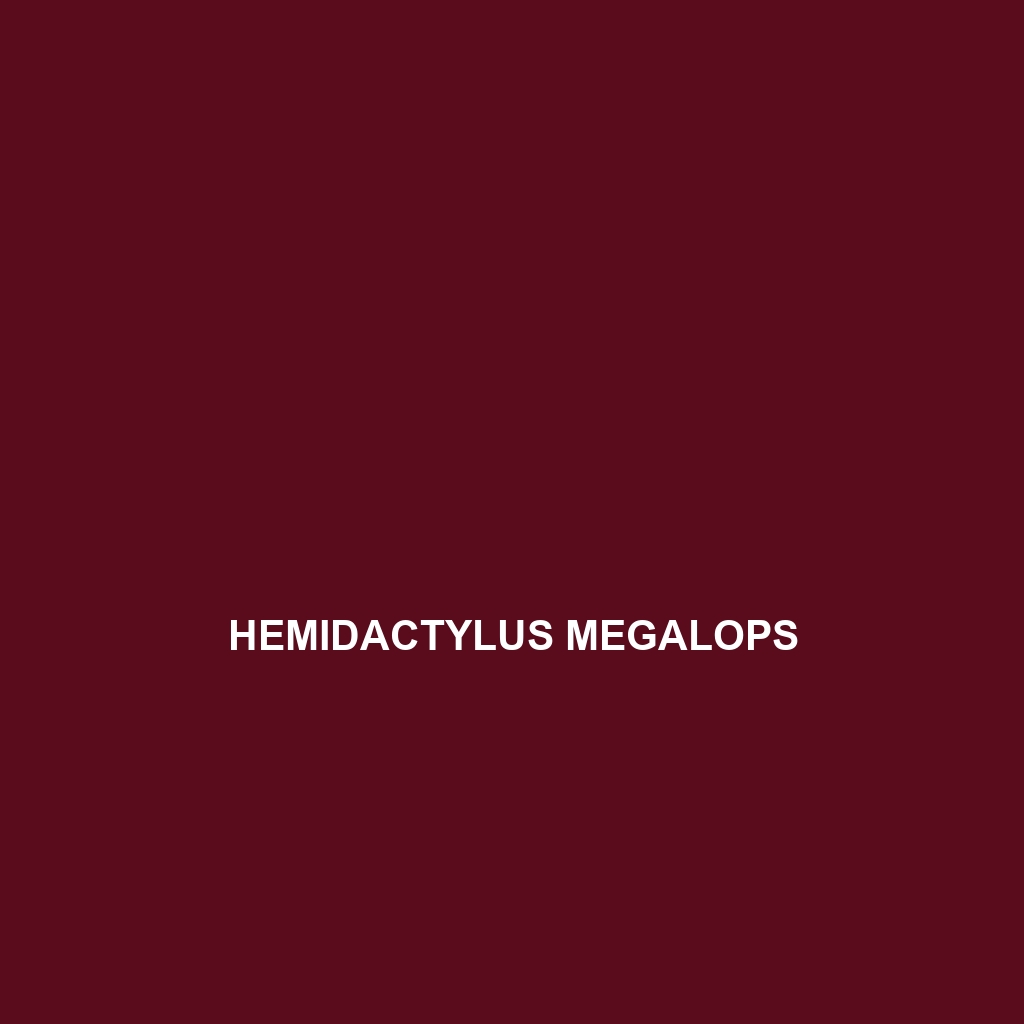Common Name
Hemidactylus megalops
Scientific Name
Hemidactylus megalops
Habitat
Hemidactylus megalops, commonly known as the large-eyed gecko, favor varied habitats primarily found in tropical and subtropical regions. This species thrives in environments such as rainforests, where humidity and temperature levels provide ideal living conditions. They are also commonly seen in savannas, showcasing their adaptability to less dense environments. During the day, these geckos tend to shelter in crevices or under leaf litter, whereas at night, they become more visible foraging in search of insects. Marine habitats or areas near coastlines are also where they can be observed, as they rely on warmth and shelter from vegetation that these sites uniquely provide.
Physical Characteristics
Hemidactylus megalops is distinctive due to its large, prominent eyes which aid its nocturnal lifestyle. Typically, adults can reach sizes of up to 10 cm in length. Their bodies are slender with a slightly elongated shape, enhancing their agility when hunting or evading predators. The coloration of Hemidactylus megalops can vary, often exhibiting a mix of browns and greys that help in camouflage among leaves and bark. Moreover, their skin is equipped with tiny scales, which assist in moisture retention, an essential trait given their rainforest habitats. Notably, they often display patterns of spots or stripes which assist in further blending into their surroundings, effectively making them difficult for both predators and prey to detect.
Behavior
As primarily nocturnal creatures, Hemidactylus megalops are most active during the night, using their acute sense of sight to navigate in darkness. They exhibit fascinating social behaviors where they often congregate in humid areas, particularly during mating periods. These geckos are known for their unique mating rituals that involve a series of vocalizations, body movements, and displays, ensuring successful courtship. Territorial in nature, males commonly engage in disputes over prime basking spots or mates, often resulting in displays of aggression through tail waving and posturing. Moreover, they possess an interesting ability to shed their tails when threatened, a survival mechanism that allows them to escape from predators.
Diet
Hemidactylus megalops is primarily an insectivore, feeding on a diverse diet that includes a wide range of insects such as crickets, beetles, and moths. Their predatory habits are crucial for controlling insect populations in their habitats. Interestingly, during times of food scarcity, they may exhibit omnivorous tendencies, consuming small fruits or nectar, which highlights their adaptability. They use their excellent night vision to hunt effectively, darting quickly and capturing prey with their agile bodies and quick reflexes.
Reproduction
The reproductive cycle of Hemidactylus megalops typically occurs during the warmer months, aligning with the peak humidity levels which facilitate successful egg laying. Females commonly lay two eggs at a time, a process that occurs several times throughout the breeding season. The eggs are usually hidden under rocks or in leaf litter for protection. The incubation period lasts around 6 to 8 weeks before hatchlings emerge. Interestingly, parental care is absent in this species, and the hatchlings are independent right from birth, utilizing their innate skills to survive in their environment.
Conservation Status
The conservation status of Hemidactylus megalops is currently listed as least concern according to the International Union for Conservation of Nature (IUCN). However, habitat destruction due to deforestation and urban development poses significant threats to their populations. Conservation efforts are essential to address these challenges, focusing on habitat preservation and restoration initiatives to ensure these geckos can thrive in their natural environments.
Interesting Facts
One of the most interesting facts about Hemidactylus megalops is its ability to change color, which is a unique adaptation aiding in camouflage and temperature regulation. Additionally, the gecko’s large eyes not only enhance its night vision but also serve a secondary purpose as a means of communication, signaling to other geckos through changes in pupil dilation. Their vocalizations can be heard during the mating season, as males advertise their presence to potential mates with melodic calls.
Role in Ecosystem
Hemidactylus megalops plays a crucial role in its ecosystem as both a predator and prey. As an insectivore, it helps maintain the balance of insect populations, contributing to the health of its habitat. Furthermore, by being a food source for various larger predators, such as birds and snakes, it supports the biodiversity and relational dynamics within its ecological community. This species is often considered an important aspect of the food web, highlighting its significance in maintaining ecological stability.
